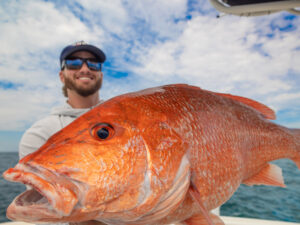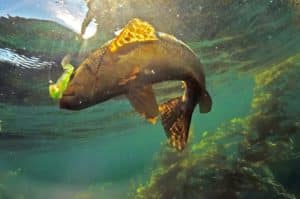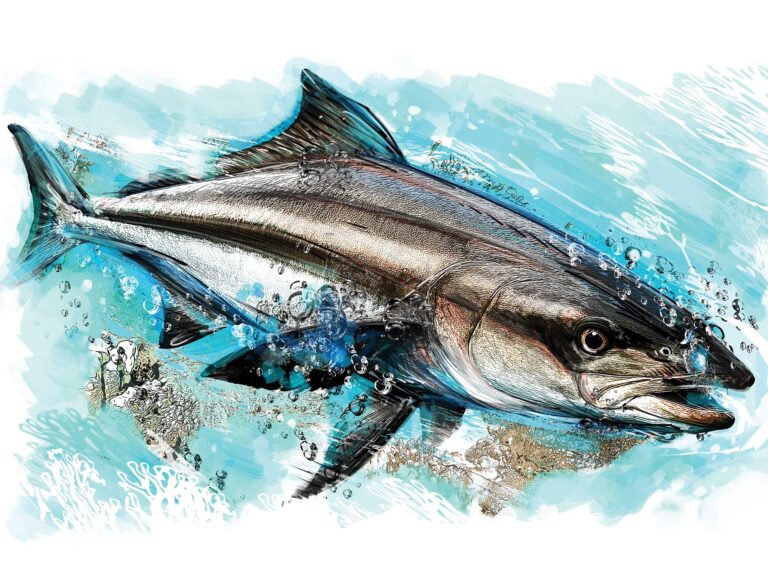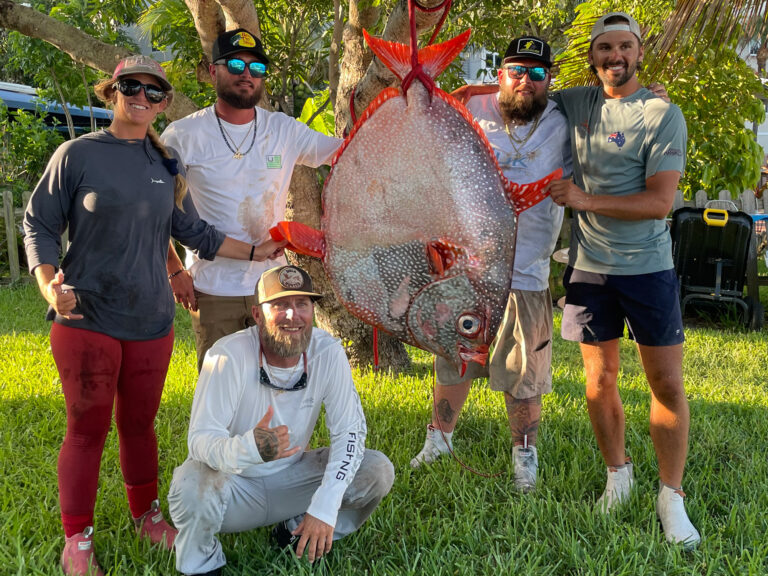
- READ MORE: Fishing’s Most Dangerous Animals — The Stingers (PART 2)
- READ MORE: Fishing’s Most Dangerous Animals — The Biters (Part 3)
Most of us don’t think of sport fishing as a particularly hazardous sport. No doubt statistics would bear out that it is not. But every sport has its own unique risks, and saltwater fishing is no exception. And as much as the odds weigh against you or me getting seriously injured by something that lives in the sea, you’d better believe it’s possible. In fact, the list of critters worldwide that wait to poke, sting, nip, swallow, infect or otherwise harm you, turns out to be a pretty long and diverse one — probably more so than most of us had ever thought.

To delve into these bad actors of the marine angler’s world, I’ve grouped them into three broad categories, describing the form their particular mischief takes, depending whether they impale, sting or munch you. (Warning: Some graphic images of injury will follow.)
Angler Stabbed by Billfish

“My wife, Denise, and I were fishing off Hannibal Bank [Panama] in December 2000. I happened to be on one boat with one of my buddies and my wife was in another boat. A friend of ours hooked a 650-pound blue marlin and brought it to the boat — very green — in about 15 minutes. Denise was filming all this with a video camera. So she’s leaning over the side to catch the action as the crew goes to tag the fish, thrashing at the gunwale. Suddenly the SOB jumps straight up, and its long bill goes through Denise’s bent forearm, running between two bones and on into her right breast — and all the way out her back! The fish shakes and almost takes her overboard, but she holds onto the rail. Fortunately, she was in great shape, being a bodybuilder, so she stays in the boat as the fish slides off. As if that weren’t bad enough, they brought her into the prison camp [adjacent to] the dock on Coiba Island but the “clinic” was dark, with the generator out, so a prisoner sewed her up with fishing line — and of course no anesthetic — by candlelight! From there, we got her to a Panamanian hospital. She had plenty of complications, but got over them and was ready to go back and fish.“ — Wayne LeBlanc, Mandeville, Louisiana
Angler Stung By Jellyfish

“Years back, I was loading a cast net to throw for mullet, using the over-the-shoulder method. Unbeknownst to me, I managed to get a box jellyfish tangled in the mesh and I didn’t see the transparent tentacles. I sure felt them, though: The pain was searing, so intense that I felt my brain would explode — much more acute than the time I sat inside a wrecked car with multiple breaks while a rescue crew cut me out.“ — Rod Harrison, Bribie Island, Australia
Angler Bitten By Jumping Mackerel

“My son, Greg, and I decided to drop the anchor and berley [chum] up a promising-looking [Western Australia] reef. I was busy berleying (chumming) while Greg caught and released a small tomato cod. Out of the corner of my eye, I saw a splash behind the boat. As I turned away from the water, to ask Greg if he’d seen the same splash, something hit me in the throat and knocked me flat on my back! Stunned and clutching my throat in pain, I noticed two halves of the tomato cod and a rather large Spanish [narrowbarred] mackerel thrashing about in the bottom of the boat. The splash I’d seen was the mackerel leaving the water after hitting the cod. … After examining my neck, we decided to head for Wickham Hospital as fast as possible. Twenty stitches later, we were back home …“ — Ken Cowey, Australia (excerpted from Western Angler magazine).
Great White Attacks Outboard Motors
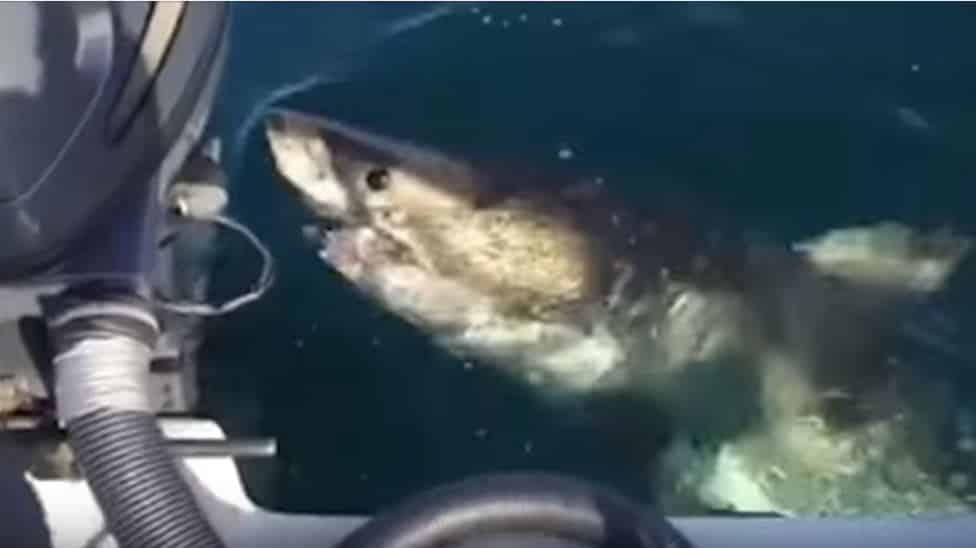
“Along with a couple surgeons and an anesthesiologist, my friend, Bob, came upon a large school of silk snapper about 30 miles west of Coiba Island off Panama. The snapper had been attracted to the surface by a spawning aggregation of congrejos (tiny red crabs the size of a quarter). Feeding on the silk snappers were cuberas from 30 to perhaps 120 pounds. Also attracted: sharks. Bob told me that in many years of fishing all over the northern hemisphere, he’d never seen so many large sharks in one place. At any moment, they could see 10 to 20 sharks from 10 to 15 feet. One, which they felt had to be a great white, appeared to be 25 feet long (longer than either of the two Mako center consoles from which the group fished). The shark soon disappeared. After a morning of snapper fishing, the two boats drifted quietly as the men ate lunch. Suddenly, the bow of one Mako reared up and started to shake. Bob grabbed the console rail and caught his buddy, sliding aft. When they turned around, they were staring at the head of a giant white shark — which had its mouth around two 55-hp Johnson outboards! Meanwhile, the guide grabbed the console with one hand and with the other, cranked the engines. Fortunately both fired up. He threw them into gear. The boat surged up and forward, then stopped immediately. They discovered one engine mangled but the other still operating, if not very well. As anglers and guide [composed themselves], they looked around and spotted the shark sinking slowly, quivering, into the clear, deep-blue depths amidst a cloud of red. I’ve known the author of this account for some time and believe it is quite possibly true.“ — The late Dr. Ray McAllister, formerly with the Department of Ocean Engineering, Florida Atlantic University, Boca Raton
Billfish Attacks in the Cockpit

To impale anything, one needs a sharp weapon such as a sword. If any fish wields a sword, the broadbill swordfish qualifies. The broadbill doesn’t hesitate to use its long sword in a sometimes-deadly fashion. Boats have been sunk after being pierced by a swordie; in fact, with surprising frequency, reports of swordfish attacking Gloucester dories were a fact of life for New England fishermen early last century.
The business end of any billfish is a weapon to be reckoned with. Some years ago, a mate off Louisiana ended up with a billfish’s bill in his head. Apparently it did no serious damage — go figure. And the same thing happened to an angler in a fighting chair off Panama.
Most often, such accidents happen when a mate is leaning over the gunwale holding onto an angry billfish. Such was the case off Islamorada, Florida, in the early 1990s where Sam Talbert worked as a mate. A deckhand by the name of Jamie on the charter boat Start Me Up had been holding onto a sailfish while the anglers snapped photos. “While Jamie was holding its bill, the sail decided to make one more jump,” Talbert says. “The tip of its bill ended up in Jamie’s nostril! We all saw him that afternoon back at Bud ‘N Mary’s [Fishing Marina] with a tissue jammed up his injured nose. He healed in a couple weeks.”
A Close Call with a Sailfish

Another South Florida close call came from now-retired Capt. Bouncer Smith, out of Miami. He endeavored to hold onto the leader with a lively sail on the end, pulled in by an 8-year-old lad whose father badly wanted photos. But the fish wasn’t in a mood to pose and jumped first away from the boat, then came charging back.
“I pushed the boy toward the stern, leaving me in line with the charging fish,” Smith recalls. “I [was] up against the livewell, leaving no room to run as the fish came over the side and hit me about 2 inches above the navel.
“Before you call the medics, it turns out that this sail had broken off the end of his bill at some time. This left him with a spear not as tapered and sharp as the tip of a pencil but more like the end of a finger. I was badly bruised — but not harpooned!”
Beat Up By a Black Marlin

From Down Under, big-game fishing photographer Alistair McGlashan recounts a much worse injury from a bigger weapon — the bill of a black marlin. A friend of his was fishing for southern yellowtail when, to the surprise of crew and anglers, a black marlin grabbed a live bait.
“The gear was totally inadequate, so — throwing caution to the wind — they rushed the fight and quickly got their hands on the trace,” McGlashan says. “Being very green, the fish continued to jump and somehow ended up impaling one of the deckhands. The bill narrowly missed his heart as it passed through his torso and out below his armpit. The boat contacted the Coast Guard as it sped back to Narooma; an ambulance met them at the wharf.” The mate survived, but doctors told him it had been a very near miss.
A near miss eluded would have suited one hapless longliner off the coast of Mexico in July 1999, when a marlin already on deck extracted its revenge, somehow managing to critically wound the fisherman with its bill. He died shortly after being airlifted to a hospital in Acapulco, according to the emergency-room doctor there, with whom I spoke.
Billfish Jabs Boat Hull

Typically, billfish that impale people do so after being hooked or caught. But that’s not always the case. Edward R. Ricciuti, in his book Killers of the Seas (Collier Books), describes an unusual case of a man sitting on the gunwale of a boat off Sierra Leone, Africa, when a swordfish ran him through the back.
While anglers clearly run some risk from the bills of the big-game trophies they hook, hulls of boats make bigger targets. As noted above, swordfish are notorious for ramming boats, often losing their bills in the process. But marlin are also compelled at times to attempt to skewer boats. Four men in an 18-footer off New South Wales, Australia, nearly sank after a billfish — probably a marlin — punched a hole in their wooden boat, according to Ricciuti. He cites another marlin attack — a 400-pound blue that ran its bill 9 inches into a sport-fishing boat off Bimini.
Certainly, the force behind the bill of a big marlin or swordie swimming at 40 or 50 mph shouldn’t be taken lightly. According to Charles Mather, in Billfish (Saltaire Publishing Ltd.), billfish have thrust their forward member into wood as deep as 22 inches and even pierced steel to a depth of 4 inches. Indeed, he offers a photo of a damaged bill that was pulled from a bale of raw rubber. More than a foot of bill had penetrated the rubber. Says Mather, “There is no bullet or projectile that can penetrate a floating bale of rubber [that] depth.”
Marlin Pulls Angler Overboard
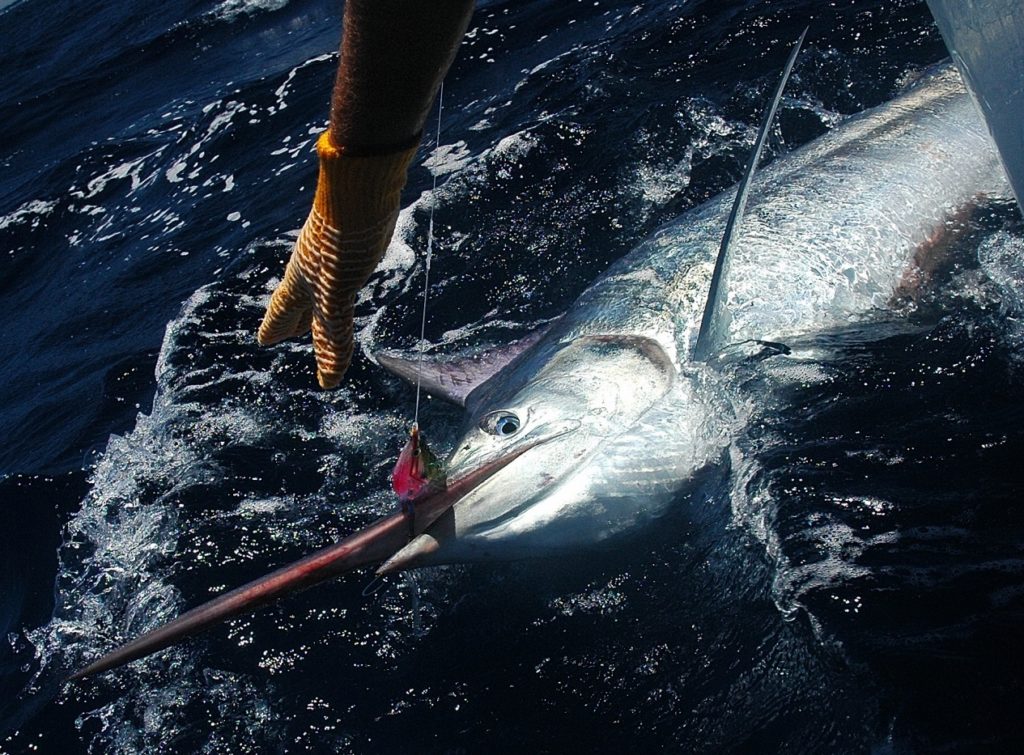
Marlin can be dangerous even without using their bills. Ask Australian skipper, deckhand, photographer and writer Dean Butler. Years ago, when he was working aboard Capt. Bill Bilson’s Viking II for a client after light-line marlin records when an estimated 225-pounder (on 6-pound tippet) came to the wire.
“You don’t get a lot of early shots when marlin-fishing for records, and when you do, you have to take them,” Butler says. So he reached out and got a gaff into the green fish, but before another deckie could sink gaff number two, Butler knew he was in trouble. As soon as the gaff bit, I knew there was no way I could hold that fish. He’d gotten his head down and was out of there. In the nanosecond it took to register, I was flying full stretch into the water!” Mindful of the Viking‘s whirring props, Butler held on. The marlin came to the surface, “and I went for a wild sleigh ride of more than 100 feet as the fish streaked across the surface, but I wised up and let go as soon as we went under again.”
Most instances of billfish impalings could have been avoided. First, if for any reason a billfish is held next to the boat or gaffed green, all bets are off. The risk is real, especially to anyone leaning over the gunwale at this point. Secondly, if attempting to hold a billfish by its bill for a photo or to remove a hook, use both hands, thumbs together and keep the bill, as you would a loaded gun, pointed away from you.
A Marlin’s Bill as a Weapon

Of course, it’s a whole different story when another person uses a billfish’s bill as a weapon — as happened in St. Petersburg, Florida, some time ago, when one fellow settled an argument with another by running him through with the preserved bill of a swordfish. The man survived the attack.
Even if not impaling a deckhand, a billfish’s bill can leave its mark.
“It’s as rough as 80-weight sandpaper!” says Capt. Dean Panos, a Miami skipper who catches and releases great numbers of sails. He has learned to wear fishing gloves: “Grab a bill with your bare hands, and when the fish decides to make a move for freedom and begins to thrash around, it will turn your hand to pulp.”
Needlefish Fishing: An Unexpected Hazard

Finally, a fish needn’t have a bill nor be very large to be a serious impaler. Consider the needlefish and its larger cousin, the houndfish. These thin fish with long, narrow jaws, swim along slowly at the surface of tropical and temperate coastal waters, but when chasing or being chased, they may bounce along, skittering over the surface at high speed for considerable distances.
Should an object — such as a person — be in the way of these living javelins, he or she can be stuck. It’s happened many times, and on occasion with fatal results. In 1977, a 10-year-old boy in Hawaii died when a needlefish leapt over a net with such force that its jaws pierced his skull.
More recently, a girl wading in the shallows of the Florida Keys ended up in an ER on a respirator after a small needlefish slammed into her neck, leaving four inches of the beak embedded, barely missing her carotid artery. In recent years, a number of other needlefish incidents have left a Florida kayaker hospitalized with broken ribs and a punctured lung and a Fillipino fisherman in a boat checking his hooks dead with a needlefish’s head going into his throat.

